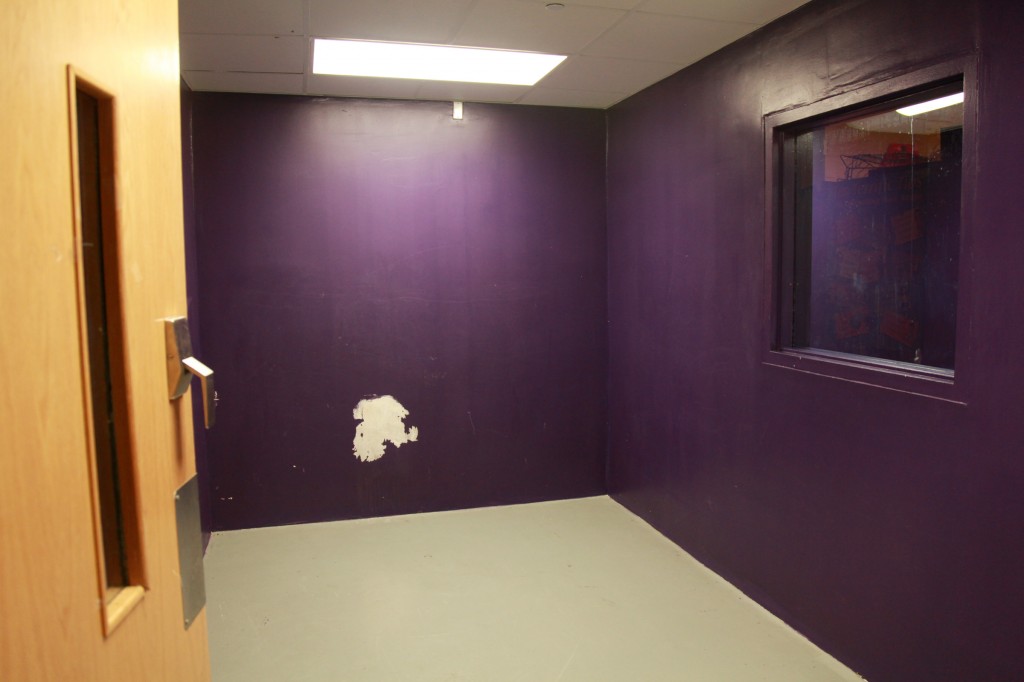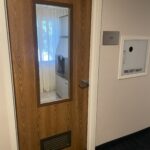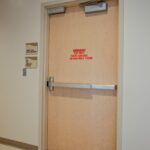We discuss school security quite often on this site, but there are a couple of other school-related issues that I’d love your feedback on (I’ll post the second one tomorrow).
 Some schools include seclusion rooms, where a child may be placed if he/she needs time to calm down without endangering themselves or others. Without getting into the discussion of whether or not a child should be contained in such a room (it’s quite a hot topic right now), let’s talk about the egress requirements. The codes require free egress from each room or space (with limited exceptions), so locking someone in a room is not an option. I have seen a couple of different methods used to secure these rooms in a way that is acceptable to the local Authority Having Jurisdiction (AHJ):
Some schools include seclusion rooms, where a child may be placed if he/she needs time to calm down without endangering themselves or others. Without getting into the discussion of whether or not a child should be contained in such a room (it’s quite a hot topic right now), let’s talk about the egress requirements. The codes require free egress from each room or space (with limited exceptions), so locking someone in a room is not an option. I have seen a couple of different methods used to secure these rooms in a way that is acceptable to the local Authority Having Jurisdiction (AHJ):
a) A mechanical lock which requires someone to hold the outside lever up or down in order for the latchbolt to be projected. If the adult who is supervising the child walks away, the latch is retracted and the door is no longer locked.
b) An electronic solution – often an electromagnetic lock, which requires someone to push a palm button outside of the seclusion room door to keep the door locked. Again, if the person stops holding the button, the door unlocks. This application would also typically unlock on fire alarm or power failure.
These methods are not addressed by the International Building Code or NFPA 101 – The Life Safety Code, but there are some state Board of Education requirements addressing these rooms, including requirements for the door hardware. For example, the Connecticut Board of Education requirements state the following:
Any room used for the seclusion of a person at risk shall:
Have a door with a lock only if that lock is equipped with a device that automatically disengages the lock in case of an emergency. Not later than January 1, 2014, the locking mechanism of any room in a public school specifically designated for use as a seclusion room shall be a pressure sensitive plate. Any latching or securing of the door, whether by mechanical means or by a provider or assistant holding the door in place to prevent the person at risk from leaving the room, shall be able to be removed in the case of any emergency.
An “emergency” for purposes of this subdivision includes, but is not limited to,
(A) the need to provide direct and immediate medical attention to the person at risk,
(B) fire,
(C) the need to remove the person at risk to a safe location during a building lockdown, or
(D) other critical situations that may require immediate removal of the person at risk from seclusion to a safe location; and
Have an unbreakable observation window located in a wall or door to permit frequent visual monitoring of the person at risk and any provider or assistant in such room. The requirement for an unbreakable observation window does not apply if it is necessary to clear and use a classroom or other room in the school building as a seclusion room for a person at risk.
This web page from the US Department of Education includes a downloadable document detailing the seclusion room requirements for each state. Here is another report from the Congressional Research Service – The Use of Seclusion and Restraint in Public Schools: The Legal Issues.
WWYD for a seclusion room? Are seclusion rooms used in your state? If yes, what has the AHJ approved as an acceptable solution for the door and hardware?
You need to login or register to bookmark/favorite this content.






Not that it has to to with the hardware problem but the designers often put a one way glass observation window on these rooms. They need to remember that in spite of what you see on the police dramas the viewer side room needs to be really dark for the one way glass to work properly. Manufacturer’s recommendations often suggest painting the room black to help minimize the amount of backlight. A one way light between the selcusion cell and a principals’ office doesn’t work.
We had a similar issue once that was for time out (control) rooms in a juvenile detention/residential establishment. There was a variance from the AHJ allowing a delayed egress VD99 on the rear exit from the dorm area. This same power supply operated mag locks on the two control rooms and a key switch was mounted on the wall by each room. These could be violent kids and it was approved. The key switch showed red or green to show status of the lock, it was tied to the fire system, the manual reset of the chex-it device was incorporated into one of the key switches, the delayed exit door could be used for entry by the fire dept by using the tamper switch in the Knox box by the outside of the exit door. Complex issue, but these were kids one step away from juvenile jail
Having worked in a psychiatric hospital, and having seen firsthand the way that some staff members try to weasel out of any job responsibility, I would expect the staff member who is supposed to be holding the lever or release button to jam the lever or button with a broomstick or other object so they could walk away and leave the room locked.
I think a fail-safe electronic release tied to the alarm would remove the “human error” aspect.
These are common in my local school district and your option B listed above is the most common although I’ve specified a hybrid of both A and B options in the past. That would be an exit-only latch (with the lever on the exterior) and a fail-safe electric strike tied to a momentary switch. The only way to secure the door is with someone keeping the momentary switch closed and maintaining power to the electric strike. And you’re correct about “time-out” rooms being a hot topic.
Would require them to meet normal exiting requirement or the requirements for “I” occupancy
Unless there is a diagnosis of mental illness or emotional problems where a qualified professional determines it is necessary for the wellbeing of the child or the public, locking a child in seclusion is tantamount to incarceration. Having staff at an observation position and requiring that staff to physically keep the lock engaged seems the most responsible approach. Constant supervision to ensure the time out is minimized is a must. Even in our state’s mental institutions, this is seen as a patient right. How can this right not be extended to a child?
Seclusion rooms are one thing; a detention room is another. In certain instances the space may serve both purposes. I like the push button, but physically, this may be difficult to hold for any period of time. A foot switch at a desk with a monitor and camera viewing the interior of the room might be easier. Multiple foot switches could be employed so that a person pushing one, could be relieved by another staff member. A point of note: video recordings of this space would likely be a “Protected Record” under FERPA. Could be a good or bad thing depending upon who’s wanting to view the video.
In our school district we call them “Quiet Rooms”, regardless they are the same thing.
We use squash court locksets which have a turnpiece recessed into the inside rosette which
always allows free egress. The outside has a lever handle which gives the staff member mechanical advantage over the occupant of the room, however if for any reason the staff member leaves his post the occupant has free egress.